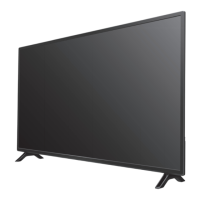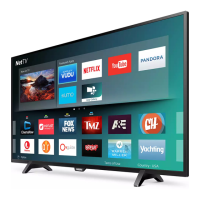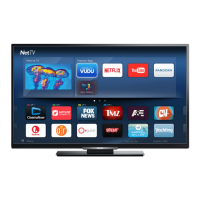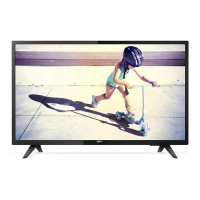Do you have a question about the Philips 43PFL5602 and is the answer not in the manual?
Explains important safety symbols for safe operation of the TV.
Provides essential tips for child safety and proper TV placement.
Lists key safety instructions for operating the television correctly.
Details on VESA standard compatibility and recommended wall mount bracket kits.
Describes structural properties of LCD displays regarding pixel appearance.
Outlines user serviceability, warranty voiding, and repair procedures.
Guidelines for TV placement and important regulatory warnings.
Information on product disposal, recycling, battery usage, and disposal.
Instructions for safely packing the unit for transport or relocation.
Highlights the main capabilities and functions of the television.
Lists all the items provided in the TV package.
Explains the meaning of symbols used throughout the user manual.
Step-by-step instructions for attaching the TV stand base securely.
Guides on inserting batteries into the remote control correctly.
Details the function of each button on the remote control for easy operation.
Explains the buttons and indicators on the TV's physical control panel.
Details all available input and output connection ports on the TV.
Guide for connecting various external TV signal sources.
Instructions and precautions for safely connecting the TV to the power outlet.
Guidance on choosing the optimal connection quality for external devices.
Detailed instructions for connecting various external devices using different cable types.
Using EasyLink for audio output to compatible devices via HDMI-ARC.
Connecting devices using component video and analog audio cables.
Steps for establishing a wired internet connection for the TV.
Steps for establishing a wireless internet connection for the TV.
Instructions for connecting a PC to the TV using HDMI or HDMI-DVI.
Connecting the TV to external digital audio devices.
Lists supported PC input video formats and refresh rates for display.
Instructions for using a USB memory stick to play photos, music, and videos.
Guides on selecting the preferred on-screen language and TV location.
Steps for configuring network connection and performing channel scans.
Configuring preferred picture and sound settings during initial setup.
How to turn the TV on, off, and put it into standby mode.
How to control the TV's volume and mute the audio output.
Methods for changing TV channels using the remote control or number buttons.
How to switch between TV sources and connected external devices.
Guide on how to access and navigate the TV's main Home menu.
Managing device lock status and rescanning TV connections.
How to create and manage lists of preferred TV channels for easy access.
Adjusting the TV's aspect ratio for different video signals and input types.
How to display current channel, program information, and aspect ratio.
Accessing and utilizing various TV settings via the options menu.
Operating connected EasyLink devices using the TV's remote control.
Adjusting power-saving features like the switch-off timer for energy efficiency.
Details supported file formats and specifications for USB media playback.
Instructions on how to view photos stored on a USB memory stick.
Instructions on how to play music files stored on a USB memory stick.
Instructions on how to play video files stored on a USB memory stick.
Guides on how to configure optimal picture and sound settings for the TV.
Provides an overview of menus for picture, sound, and TV usage settings.
Guides for installing channels and configuring network connections.
Instructions on how to update the TV's software for improved performance.
Explains adjustments for backlight, contrast, color, tint, sharpness, and more.
How to select picture formats and display modes for optimal viewing.
Adjusting the horizontal and vertical position of the displayed picture.
Fine-tuning advanced picture enhancement features for clarity and smoothness.
Configuring settings like color alignment, HDR, and gamma for picture quality.
Choosing predefined sound modes for spatial or surround sound reproduction.
Managing auto volume leveling, TV speakers, and headphone volume.
Selecting digital audio output format and adjusting delta volume.
Explains the various features available on the TV.
Guides on setting up the TV, including channel installation and restoring defaults.
How to select the preferred language for the TV's on-screen display.
Selecting TV placement and configuring retail demo mode settings.
Adjusting HDMI settings and understanding EasyLink features for device control.
Explains one-touch play, standby, system audio control, and key forwarding.
Operating linked devices via EasyLink and restoring default settings.
Configuring accessibility features such as voice guide and caption settings.
Setting up and displaying closed captions for analog and digital TV broadcasts.
Customizing the appearance of digital captions, including font, color, and background.
Setting audio explanations and selecting preferred audio languages for digital broadcasts.
Guides for installing, searching, and removing TV channels.
Preventing children from accessing certain programs using PIN or ratings.
Configuring program rating locks to control content viewing based on age and content.
Procedures for changing the TV's PIN code for enhanced security.
Choosing the preferred audio language for digital broadcasts.
Selecting the audio format for analog TV broadcasts.
Step-by-step instructions for connecting the TV to a wireless network.
Instructions for establishing a wired internet connection using an Ethernet cable.
Manually configuring network parameters like SSID, WEP/others key.
Detailed setup options for wireless network connections, including Auto, Easy Connect, and Manual.
Setting up the wireless connection by manually entering the network name and authentication type.
Configuring IP address, DNS, and gateway settings manually for network access.
Testing the internet and home network connection status to ensure proper functionality.
Verifying the configured network settings, including MAC address.
Configuring the TV to play media from home network servers (DMR).
Managing Net TV, YouTube, and Netflix service settings and deactivation.
Restoring network settings to their default values to resolve connection issues.
Lists the requirements and initial steps before upgrading the TV software.
Step-by-step instructions for updating TV software using a USB memory stick.
Instructions for updating TV software over the internet connection.
Viewing current software version and managing automatic update notifications.
Details regarding open source software licenses used in the product.
Instructions for mirroring smartphone, tablet, or PC screen to the TV wirelessly.
Guidelines for playing media files stored on home network media servers.
Steps to access and browse media files on home network servers.
Displaying photos stored on home network media servers with playback controls.
Listening to music files stored on home network media servers with playback controls.
Viewing video files stored on home network media servers with playback controls.
Browsing internet services and apps available through Net TV.
Functions for removing or repositioning apps within the App Gallery.
Information on where to find details for third-party internet services like Netflix.
Solutions for common problems with the remote control and signal reception.
Troubleshooting steps for initial setup, channel reception, and program viewing.
Resolving issues with closed caption display and forgotten PIN codes.
Solutions for scenarios where the TV displays no picture or sound.
Addressing common issues related to picture quality, color, and clarity.
Troubleshooting issues with distorted sound, intermittent audio, or incorrect sound.
Resolving problems with screen size changes or color variations.
Solutions for issues related to closed caption display, including black boxes.
Diagnosing and resolving problems with network connection and wireless performance.
Addressing potential compatibility issues with wireless screencasting devices.
Definitions of technical terms and acronyms used in the manual.
Instructions for cleaning the TV and general maintenance practices.
Guidance on seeking professional service and checking the remote's IR signal.
Technical details on display type, resolution, audio output, and sound modes.
Details on input/output ports, wireless standards, and power requirements.
Information on warranty coverage, service procedures, and exclusions.
Information regarding open source software licenses and obtaining source code.
Explains important safety symbols for safe operation of the TV.
Provides essential tips for child safety and proper TV placement.
Lists key safety instructions for operating the television correctly.
Details on VESA standard compatibility and recommended wall mount bracket kits.
Describes structural properties of LCD displays regarding pixel appearance.
Outlines user serviceability, warranty voiding, and repair procedures.
Guidelines for TV placement and important regulatory warnings.
Information on product disposal, recycling, battery usage, and disposal.
Instructions for safely packing the unit for transport or relocation.
Highlights the main capabilities and functions of the television.
Lists all the items provided in the TV package.
Explains the meaning of symbols used throughout the user manual.
Step-by-step instructions for attaching the TV stand base securely.
Guides on inserting batteries into the remote control correctly.
Details the function of each button on the remote control for easy operation.
Explains the buttons and indicators on the TV's physical control panel.
Details all available input and output connection ports on the TV.
Guide for connecting various external TV signal sources.
Instructions and precautions for safely connecting the TV to the power outlet.
Guidance on choosing the optimal connection quality for external devices.
Detailed instructions for connecting various external devices using different cable types.
Using EasyLink for audio output to compatible devices via HDMI-ARC.
Connecting devices using component video and analog audio cables.
Steps for establishing a wired internet connection for the TV.
Steps for establishing a wireless internet connection for the TV.
Instructions for connecting a PC to the TV using HDMI or HDMI-DVI.
Connecting the TV to external digital audio devices.
Lists supported PC input video formats and refresh rates for display.
Instructions for using a USB memory stick to play photos, music, and videos.
Guides on selecting the preferred on-screen language and TV location.
Steps for configuring network connection and performing channel scans.
Configuring preferred picture and sound settings during initial setup.
How to turn the TV on, off, and put it into standby mode.
How to control the TV's volume and mute the audio output.
Methods for changing TV channels using the remote control or number buttons.
How to switch between TV sources and connected external devices.
Guide on how to access and navigate the TV's main Home menu.
Managing device lock status and rescanning TV connections.
How to create and manage lists of preferred TV channels for easy access.
Adjusting the TV's aspect ratio for different video signals and input types.
How to display current channel, program information, and aspect ratio.
Accessing and utilizing various TV settings via the options menu.
Operating connected EasyLink devices using the TV's remote control.
Adjusting power-saving features like the switch-off timer for energy efficiency.
Details supported file formats and specifications for USB media playback.
Instructions on how to view photos stored on a USB memory stick.
Instructions on how to play music files stored on a USB memory stick.
Instructions on how to play video files stored on a USB memory stick.
Guides on how to configure optimal picture and sound settings for the TV.
Provides an overview of menus for picture, sound, and TV usage settings.
Guides for installing channels and configuring network connections.
Instructions on how to update the TV's software for improved performance.
Explains adjustments for backlight, contrast, color, tint, sharpness, and more.
How to select picture formats and display modes for optimal viewing.
Adjusting the horizontal and vertical position of the displayed picture.
Fine-tuning advanced picture enhancement features for clarity and smoothness.
Configuring settings like color alignment, HDR, and gamma for picture quality.
Choosing predefined sound modes for spatial or surround sound reproduction.
Managing auto volume leveling, TV speakers, and headphone volume.
Selecting digital audio output format and adjusting delta volume.
Explains the various features available on the TV.
Guides on setting up the TV, including channel installation and restoring defaults.
How to select the preferred language for the TV's on-screen display.
Selecting TV placement and configuring retail demo mode settings.
Adjusting HDMI settings and understanding EasyLink features for device control.
Explains one-touch play, standby, system audio control, and key forwarding.
Operating linked devices via EasyLink and restoring default settings.
Configuring accessibility features such as voice guide and caption settings.
Setting up and displaying closed captions for analog and digital TV broadcasts.
Customizing the appearance of digital captions, including font, color, and background.
Setting audio explanations and selecting preferred audio languages for digital broadcasts.
Guides for installing, searching, and removing TV channels.
Preventing children from accessing certain programs using PIN or ratings.
Configuring program rating locks to control content viewing based on age and content.
Procedures for changing the TV's PIN code for enhanced security.
Choosing the preferred audio language for digital broadcasts.
Selecting the audio format for analog TV broadcasts.
Step-by-step instructions for connecting the TV to a wireless network.
Instructions for establishing a wired internet connection using an Ethernet cable.
Manually configuring network parameters like SSID, WEP/others key.
Detailed setup options for wireless network connections, including Auto, Easy Connect, and Manual.
Setting up the wireless connection by manually entering the network name and authentication type.
Configuring IP address, DNS, and gateway settings manually for network access.
Testing the internet and home network connection status to ensure proper functionality.
Verifying the configured network settings, including MAC address.
Configuring the TV to play media from home network servers (DMR).
Managing Net TV, YouTube, and Netflix service settings and deactivation.
Restoring network settings to their default values to resolve connection issues.
Lists the requirements and initial steps before upgrading the TV software.
Step-by-step instructions for updating TV software using a USB memory stick.
Instructions for updating TV software over the internet connection.
Viewing current software version and managing automatic update notifications.
Details regarding open source software licenses used in the product.
Instructions for mirroring smartphone, tablet, or PC screen to the TV wirelessly.
Guidelines for playing media files stored on home network media servers.
Steps to access and browse media files on home network servers.
Displaying photos stored on home network media servers with playback controls.
Listening to music files stored on home network media servers with playback controls.
Viewing video files stored on home network media servers with playback controls.
Browsing internet services and apps available through Net TV.
Functions for removing or repositioning apps within the App Gallery.
Information on where to find details for third-party internet services like Netflix.
Solutions for common problems with the remote control and signal reception.
Troubleshooting steps for initial setup, channel reception, and program viewing.
Resolving issues with closed caption display and forgotten PIN codes.
Solutions for scenarios where the TV displays no picture or sound.
Addressing common issues related to picture quality, color, and clarity.
Troubleshooting issues with distorted sound, intermittent audio, or incorrect sound.
Resolving problems with screen size changes or color variations.
Solutions for issues related to closed caption display, including black boxes.
Diagnosing and resolving problems with network connection and wireless performance.
Addressing potential compatibility issues with wireless screencasting devices.
Definitions of technical terms and acronyms used in the manual.
Instructions for cleaning the TV and general maintenance practices.
Guidance on seeking professional service and checking the remote's IR signal.
Technical details on display type, resolution, audio output, and sound modes.
Details on input/output ports, wireless standards, and power requirements.
Information on warranty coverage, service procedures, and exclusions.
Information regarding open source software licenses and obtaining source code.
| Screen shape | Flat |
|---|---|
| Response time | 9 ms |
| Display diagonal | 43 \ |
| Display technology | LED |
| Native aspect ratio | 16:9 |
| Supported video modes | 480i, 480p, 720p, 1080i, 1080p, 2160p |
| Contrast ratio (typical) | 1100:1 |
| Display diagonal (metric) | 109.22 cm |
| Screen format adjustments | 4:3, 14:9, 16:9, Auto, Zoom |
| Motion interpolation technology | - |
| Equalizer | Yes |
| RMS rated power | 16 W |
| Number of speakers | 2 |
| Equalizer bands quantity | 5 |
| AC input voltage | 120 V |
| AC input frequency | 60 Hz |
| Power consumption (standby) | 0.5 W |
| Power consumption (typical) | 90 W |
| Product color | Black |
| Panel mounting interface | 300 x 200 mm |
| 3D | No |
| Cord length | 1.5 m |
| Weight (with stand) (imperial) | 17.2 lbs |
| Dimensions (W x D x H) (imperial) | 38.1 x 3.4 x 22.7 \ |
| Wi-Fi standards | Wi-Fi 5 (802.11ac) |
| Audio formats supported | WAVE, AAC, AC3, MP3 |
| Image formats supported | JPG |
| Video formats supported | AVC, H.264, H.265, MPEG1, MPEG2, MPEG4 |
| Video compression formats | AVC, H.264, H.265, HEVC, MPEG1, MPEG2, MPEG4 |
| Tuner type | Analog & digital |
| Supported TV bands | UHF, VHF |
| Analog signal format system | NTSC |
| Digital signal format system | ATSC |
| USB 2.0 ports quantity | USB 2.0 ports have a data transmission speed of 480 Mbps, and are backwards compatible with USB 1.1 ports. You can connect all kinds of peripheral devices to them. |
| Component video (YPbPr/YCbCr) in | 1 |
| Consumer Electronics Control (CEC) | EasyLink |
| Operating temperature (T-T) | 5 - 35 °C |
| Package depth | 162.56 mm |
| Package width | 1059.18 mm |
| Package height | 650.24 mm |
| Package weight | 10206 g |
| Depth (with stand) | 185.42 mm |
|---|---|
| Height (with stand) | 607.06 mm |
| Weight (with stand) | 7802 g |
| Depth (without stand) | 86.36 mm |
| Width (without stand) | 967.74 mm |
| Height (without stand) | 576.58 mm |
| Weight (without stand) | 7711 g |












